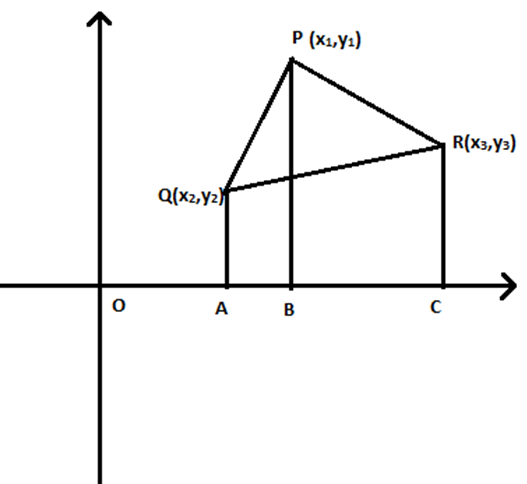Area of a Triangle In Coordinate Geometry
In Geometry, a triangle is a 3 – sided polygon which has 3 edges and 3 vertices. Area of the triangle is a measure of the space covered by the triangle in the two-dimensional plane. In this article, let us discuss what the area of a triangle is and different methods used to find the area of a triangle in coordinate geometry.
| Also, read: |
Methods to Find the Area of a Triangle
Area of a triangle can be found using three different methods. The three different methods are discussed below
Method 1
When the base and altitude of the triangle are given.
Area of the triangle, A = bh/2 square units
Where b and h are base and altitude of the triangle, respectively.
Method 2
When the length of three sides of the triangle are given, the area of a triangle can be found using the Heron’s formula.
Therefore, the area of the triangle is calculated using the equation,
A = \( \sqrt{s(s~-~a)~(s~-~b)~(s~-~c)} \)
Where a, b, c are the side lengths of the triangle and s is the semi perimeter
The value of s is found using the formula
s = \( \frac {a~+~b~+~c}{2} \)
Method 3
If the vertices of a triangle are given, first we have to find the length of three sides of a triangle. The length can be found using the distance formula.
The procedure to find the area of a triangle when the vertices in the coordinate plane is known.
Let us assume a triangle PQR, whose coordinates P, Q, and R are given as (x1, y1), (x2, y2), (x3, y3), respectively.

From the figure, the area of a triangle PQR, lines such as \( \overleftrightarrow {QA}\), \( \overleftrightarrow {PB}\) and \( \overleftrightarrow {RC}\) are drawn from Q, P and R, respectively perpendicular to x – axis.
Now, three different trapeziums are formed such as PQAB, PBCR and QACR in the coordinate plane.
Now, calculate the area of all the trapeziums.
Therefore, the area of ∆PQR is calculated as, Area of ∆PQR=[Area of trapezium PQAB + Area of trapezium PBCR] -[Area of trapezium QACR] —-(1)
Finding Area of a Trapezium PQAB
We know that the formula to find the area of a trapezium is
Since Area of a trapezium = (1/2) (sum of the parallel sides)×(distance between them)
Area of trapezium PQAB = (1/2)(QA + PB) × AB
QA = y2
PB = y1
AB = OB – OA = x1 – x2
Area of trapezium PQAB = (1/2)(y1 + y2)(x1 – x2 ) —-(2)
Finding Area of a Trapezium PBCR
Area of trapezium PBCR =(1/2) (PB + CR) × BC
PB = y1
CR = y3
BC = OC – OB =x3 – x1
Area of trapezium PBCR =(1/2) (y1 + y3 )(x3 – x1) —-(3)
Finding Area of a Trapezium QACR
Area of trapezium QACR = (1/2) (QA + CR) × AC
QA = y2
CR = y3
AC = OC – OA = x3 – x2
Area of trapezium QACR =(1/2)(y2 + y3 ) (x3 – x2 )—-(4)
Substituting (2), (3) and (4) in (1),
Area of ∆PQR = (1/2)[(y1 + y2)(x1 – x2 ) + (y1 + y3 )(x3 – x1) – (y2 + y3 ) (x3 – x2 )]
A = (1/2) [x1 (y2 – y3 ) + x2 (y3 – y1 ) + x3(y1 – y2)]
Special Case:
If one of the vertices of the triangle is the origin, then the area of the triangle can be calculated using the below formula.
Area of a triangle with vertices are (0,0), P(a, b), and Q(c, d) is
A = (1/2)[0(b – d) + a(d – 0) + c(0 – b)]
A = (ad – bc)/2
If area of triangle with vertices P(x1, y1), Q(x2, y2) and R(x3, y3) is zero, then (1/2) [x1 (y2 – y3 ) + x2 (y3 – y1 ) + x3(y1 – y2)] = 0 and the points P(x1, y1), Q(x2, y2) and R(x3, y3)are collinear.
Area of a Triangle in Coordinate Geometry Example
Example: What is the area of the ∆ABC whose vertices are A(1, 2), B(4, 2) and C(3, 5)?
Solution:
Using the formula,
A = (1/2) [x1 (y2 – y3 ) + x2 (y3 – y1 ) + x3(y1 – y2)]
A = (1/2) [1(2 – 5) + 4(5 – 2) + 3(2 – 2)]
A = (1/2) [-3 + 12]= 9/2 square units.
Therefore, the area of a triangle ABC is 9/2 square units.

To know more about coordinate geometry and areas of polygons in a coordinate plane, log onto www.byjus.com. To watch interesting videos on the topic, download BYJU’S – The Learning App from Google Play Store.